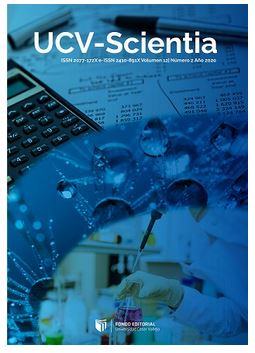Optimización de la cantidad de coagulantes para la producción de agua potable en zonas de la sierra del Perú
DOI:
https://doi.org/10.18050/revucv-scientia.v12i1.920Palabras clave:
Agua potable, Algoritmos genéticos, Jar TestResumen
Las empresas públicas o privadas productoras de agua potable deben usar la cantidad óptima de coagulante (Al2SO4) en la producción del agua potable por el beneficio económico y el cuidado de la salud teniendo en cuenta a las ciudades de la sierra ubicadas sobre los 3200 m.s.n.m. La dosis óptima de coagulante es una operación crítica, que tiene como propósito precipitar la cantidad de impurezas presentes en el agua cruda, su exceso altera la calidad del agua ocasionado daños en la salud cuando los parámetros están fuera de los límites permisibles por la OMS. El uso de los algoritmos genéticos permitió determinar la cantidad óptima de coagulante (sulfato de aluminio). Sin embargo, en la actualidad se realiza de manera manual mediante pruebas de ensayo denominadas pruebas “Jar Test” éstas se realizan en laboratorio, pero, es costos y demora mucho tiempo. Los parámetros utilizados en la simulación son: pH, turbidez, sólidos totales disueltos y conductividad, los cuales miden la cantidad de coagulantes a la entrada y salida en un periodo de tiempo, la precisión alcanzada con este método es del 99,2% con un margen de error de 0,8%, en comparación con otros métodos como las neuronales que alcanzan un resultado del 98% con un margen de error de 2%. La cantidad de coagulante está dentro de los parámetros que establece la organización mundial de la salud evitando problemas de cáncer en la población de las zonas de la sierra, alcanzando los estándares de calidad.
Referencias
Arauco Esquivel, S. E., & Peña Rojas, A. C. (2016). Aplicación de los algoritmos Geneticos para Optimizacion y Control de la Dosificacion de Coagulantes en la Empresa SEDAM HUANCAYO. UNCP - Centro de Investigación, II(14), 12.
Arranz de la Peña, J., & Parra , T. A. (2015). Algoritmos Geneticos . Madrid - España: --.
Berzal, F. (2012). Algoritmos Geneticos . DECSAI - Departamento de las Ciencia de la Computación, I(12), 8.
Carrión, P., Lopez, E., Ortega, J., & De Juan, A. (2003). Optimización mediante algortimos geneticos de la gestión de agua en el regadío. Revista Internacional de Metodos Numericos para Cálculo y Diseño en Ingenieria, 19(4), 447 - 462.
Gallego M., S., Nigro, H., & Gonzales Cisario, S. (2016). Algoritmos Geneticos para la extraccion de Reglas de Predicción Intersantes Aplicadas al Posicionamiento de los distintos Motores de Busquedas. INTIA, Departamento de Computacion y Sistemas, II(23), 8.
Gulay Tezel, E., & R. Kaan Sinan. (2009). Artificial Neural Network (ANN) Model for Wastewater Treatment Plant Control. . Selcuk University Computer Engineering Departament, Kampus Konya , I(12), 6.
Matlab (R). (2015). Manual de Matlab.
Parra Truyol, A. (2013). Algoritmos Geneticos. Universdad Carlos Tercero, II(12), 8.
Peña Rojas, A. C. (2014). Aplicación de Redes Neuronales para la Optimización y Control de la Dosificación de Coagulante en la Planta de Servicio de Agua Potable Municipal de Huancayo. Lima: Universidad la Molina.
Rincon O., J. (2006.). Aplicación de Algoritmo Geneticos en la Optimizacion del Sistema de Abastecimiento de Agua de Barquisimeto - Cabudare. Avance de Recursos Hdraulicos., I(14), 15.
Saint Gerons , A., & Mota Adrados, J. M. (2010). Desarrollo de una red Neuronal para Estimar el Oxigeno Disuelto en el Agua a partir de Instrumentación de E.D.A.R. Funcación CETENASA, Poligono Mocholi Plaza Cein N° Noain , II(20), 10.
Villalba, G., & Saldarriaga G., J. (2005). Algoritmos de Optimización Combinatoria (AOC) Aplicado al Diseño de Redes de Distribución de agua potable. Seminario Internacional “Gestión de Servicios Relaconados con el agua en asentamientos nucleados”, --(--), 10.
Descargas
Publicado
Número
Sección
Licencia

Esta obra está bajo una licencia internacional Creative Commons Atribución-NoComercial 4.0.
- Compartir — copiar y redistribuir el material en cualquier medio o formato
- Adaptar — remezclar, transformar y crear a partir del material
- El licenciador no puede revocar estas libertades mientras cumpla con los términos de la licencia.
Bajo las condiciones siguientes:
-
Reconocimiento — Debe reconocer adecuadamente la autoría, proporcionar un enlace a la licencia e indicar si se han realizado cambios<. Puede hacerlo de cualquier manera razonable, pero no de una manera que sugiera que tiene el apoyo del licenciador o lo recibe por el uso que hace.
- No hay restricciones adicionales — No puede aplicar términos legales ni medidas tecnológicas que restrinjan legalmente a otras a hacer cualquier uso permitido por la licencia.













